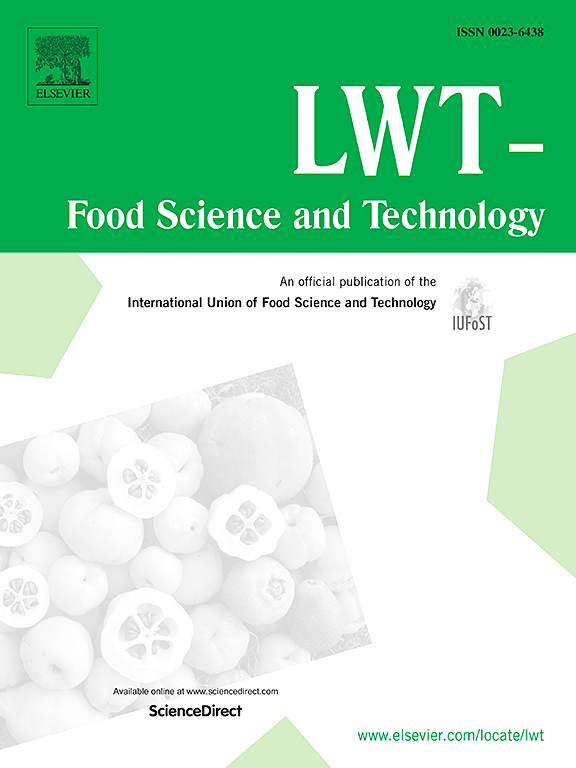评估食用昆虫的蛋白质质量:使用 DIAAS 方法对家养蟋蟀、黄粉虫和蝗虫进行比较分析
IF 6
1区 农林科学
Q1 FOOD SCIENCE & TECHNOLOGY
引用次数: 0
摘要
食用昆虫作为一种可持续的营养食物来源,为解决粮食安全挑战提供了一种解决方案,因而备受关注。它们富含蛋白质、健康脂肪以及维生素和矿物质等必需营养素。本研究调查了三种可食用昆虫--蟋蟀、黄粉虫和蝗虫--的蛋白质质量。结果表明,所有昆虫都富含蛋白质,每 100 克干重的蛋白质含量从 67.49 克到 72.36 克不等,必需氨基酸种类齐全,尤其是亮氨酸含量较高。总蛋白质消化率反映了吸收蛋白质的百分比,从 74.47% 到 85.18% 不等,表明人体对蛋白质的利用率很高。为了更全面地评估蛋白质质量,本研究采用了可消化不可缺少氨基酸评分(DIAAS),根据人体对必需氨基酸的需求,提供了一种全面的蛋白质质量评估方法。DIAAS 采用了三种计算方法,包括 6.25 的通用换算系数、5.33 的昆虫专用换算系数和氨基酸总和。使用 5.33 转换系数计算蛋白质的 DIAAS 值高于使用 6.25 转换系数的 DIAAS 值。基于干物质中单个氨基酸总和的方法提供的 DIAAS 值依次为家蟋的 DIAAS 值为 96.61 ± 8.86%,蝗虫的 DIAAS 值为 89.71 ± 9.22%,黄粉虫的 DIAAS 值为 103.32 ± 10.11%。这些发现凸显了准确测定蛋白质含量的重要性及其对评估食用昆虫营养质量的影响。本文章由计算机程序翻译,如有差异,请以英文原文为准。

Evaluating protein quality in edible insects: A comparative analysis of house cricket, yellow mealworm, and migratory locust using DIAAS methodologies
Edible insects have garnered attention as a sustainable and nutritious food source, offering a solution to food security challenges. They are rich in protein, healthy fats, and essential nutrients like vitamins and minerals. This study investigated the protein quality of three edible insect species—Acheta domesticus (house cricket), Tenebrio molitor (yellow mealworm), and Locusta migratoria (migratory locust). The results demonstrated that all insects are rich in protein, ranging from 67.49 to 72.36 g per 100 g of dry weight, with a complete profile of essential amino acids, notably high in leucine. The total protein digestibility, reflecting the percentage of absorbed protein, ranged from 74.47% to 85.18%, indicating efficient utilization by the human body. In order to provide a more comprehensive assessment of protein quality, this study employed the digestible indispensable amino acid score (DIAAS), offering a comprehensive approach to protein quality assessment based on the human body's requirements for essential amino acids. For DIAAS, three calculation methods were used, incorporating a universal conversion factor of 6.25, an insect-specific conversion factor of 5.33, and the sum of amino acids. Using a conversion factor of 5.33 for protein calculation resulted in higher DIAAS values than using a factor of 6.25. The method based on the sum of individual amino acids in the dry matter provided the DIAAS values in the following order: 96.61 ± 8.86% for house cricket, 89.71 ± 9.22% for migratory locust, and 103.32 ± 10.11% for yellow mealworm, indicating good to excellent protein quality for all insect species. These findings highlight the importance of accurate protein content determination and its impact on assessing the nutritional quality of edible insects.
求助全文
通过发布文献求助,成功后即可免费获取论文全文。
去求助
来源期刊

LWT - Food Science and Technology
工程技术-食品科技
CiteScore
11.80
自引率
6.70%
发文量
1724
审稿时长
65 days
期刊介绍:
LWT - Food Science and Technology is an international journal that publishes innovative papers in the fields of food chemistry, biochemistry, microbiology, technology and nutrition. The work described should be innovative either in the approach or in the methods used. The significance of the results either for the science community or for the food industry must also be specified. Contributions written in English are welcomed in the form of review articles, short reviews, research papers, and research notes. Papers featuring animal trials and cell cultures are outside the scope of the journal and will not be considered for publication.
 求助内容:
求助内容: 应助结果提醒方式:
应助结果提醒方式:


